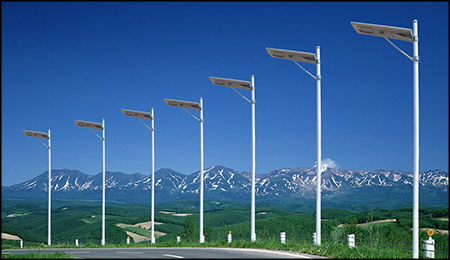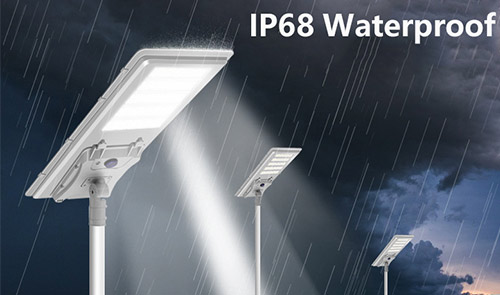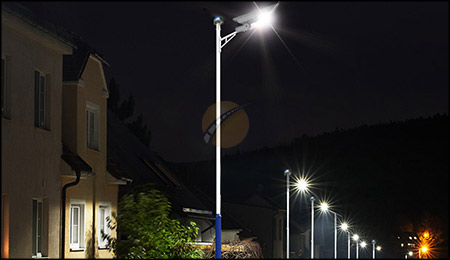How Power Influences the Brightness of Solar Street Lights
Aug 12, 2024
Solar street lights have become a popular choice for outdoor lighting due to their sustainability, low maintenance costs, and independence from the electrical grid. However, one of the critical factors that determine the effectiveness of these lights is their brightness, which is directly influenced by the power output of the system. This article explores the relationship between power and brightness in solar street lights, explaining how different components interact to deliver optimal illumination.
The power in a solar street light system is primarily generated by the solar panel, which converts sunlight into electrical energy. The power output of the solar panel is measured in watts (W) and is influenced by factors such as panel size, efficiency, and the amount of sunlight received.
Power Consumption:
The power generated is used to charge a battery, which then powers the LED (light-emitting diode) or other types of bulbs in the street light. The power consumption of the light itself is also measured in watts, and it determines the amount of energy the light uses to produce illumination.
Brightness, in the context of solar led street lights, refers to the amount of light emitted by the lamp, measured in lumens (lm). The higher the lumen rating, the brighter the light. However, brightness is not only about lumens; it also depends on the distribution of light, color temperature, and the quality of the LED or bulb.
Power vs. Lumens:
The power supplied to the LED or bulb directly affects its brightness. Typically, the higher the wattage, the more lumens the light produces. However, it’s important to note that advancements in LED technology have made it possible to achieve high brightness with lower power consumption.
Efficiency Matters:
The efficiency of the solar panel and the LED plays a significant role in the relationship between power and brightness. A more efficient solar panel can generate more power from the same amount of sunlight, while a more efficient LED can produce more lumens per watt. This efficiency reduces the amount of power needed to achieve the desired brightness.
The efficiency of the solar panel is crucial for determining how much power is available to the light. High-efficiency panels, such as monocrystalline or polycrystalline solar panels, can generate more power even in low-light conditions, ensuring that the battery is adequately charged.
Battery Capacity and Health:
The battery stores the power generated by the solar panel during the day and supplies it to the light at night. A larger battery capacity allows for more power to be stored, which can be used to maintain brightness throughout the night. However, the health of the battery is also important—old or degraded batteries may not hold enough charge, leading to reduced brightness. LED Quality and Efficiency:
LED Quality and Efficiency:
The quality of the LED or bulb used in the solar street light is another critical factor. High-quality LEDs are designed to be more efficient, producing more light with less power. The color temperature of the LED (measured in Kelvins) also influences perceived brightness; for example, cooler white lights often appear brighter than warmer tones at the same lumen level.
Light Distribution and Design:
The design of the solar street light, including the reflector and lens, affects how the light is distributed. Even with sufficient power, poor light distribution can result in areas of uneven illumination, reducing the overall effectiveness of the light. Properly designed lights maximize the impact of the power supplied by focusing it where it’s needed most.
To ensure consistent brightness, it’s essential to choose a solar panel that matches the light’s power requirements. For areas with less sunlight, larger or more efficient panels may be needed to generate sufficient power.
Battery Sizing and Management:
Choosing a battery with the appropriate capacity is crucial for maintaining brightness throughout the night. It’s also important to implement a good battery management system that prevents overcharging and deep discharging, which can prolong battery life and maintain brightness.
Using High-Efficiency LEDs:
Investing in high-efficiency LEDs can significantly enhance the brightness of solar outdoor lights without increasing power consumption. This allows for better illumination while keeping the system's energy requirements low.
Smart Controls and Dimming Features:
Integrating smart controls and dimming features can optimize power usage. For instance, lights can operate at full brightness during peak hours and dim during off-peak times, conserving power without compromising safety. Motion sensors can also be used to adjust brightness dynamically, providing full illumination only when movement is detected.
The amount of power generated by solar panels varies with weather conditions. Prolonged cloudy or rainy periods can reduce power generation, leading to lower brightness. To mitigate this, it’s important to consider the local climate when sizing the solar panel and battery.
Seasonal Changes:
In regions with significant seasonal changes, the duration of daylight varies throughout the year. During shorter winter days, less power may be generated, which can affect brightness if the system isn’t designed to compensate for these variations.
Installation and Maintenance:
Proper installation is key to ensuring that the solar panels receive maximum sunlight. Regular maintenance, such as cleaning the panels and checking the battery, can also help maintain optimal power output and brightness.
In cities, solar street lights are often used in parks, pathways, and parking lots. To achieve high brightness, these installations typically use high-efficiency solar panels and LEDs. Smart controls are also common, allowing lights to dim during low-traffic hours, conserving energy without sacrificing safety.
Rural Areas:
In rural areas, where access to the electrical grid may be limited, solar road lights are crucial. Here, the focus is on maximizing brightness with minimal power consumption. Large batteries are often used to store power during sunny days, ensuring consistent brightness during cloudy periods.
Highway Lighting:
On highways, solar street lights must provide consistent, high-brightness illumination for safety. These systems often feature large solar panels, high-capacity batteries, and LEDs that deliver maximum lumens per watt.
The brightness of solar street lights is a function of the power generated by the solar panels, the capacity and health of the battery, and the efficiency of the LED or light source. By optimizing these components, it is possible to achieve high brightness while minimizing energy consumption. As technology advances, solar street lights are becoming more efficient, reliable, and cost-effective, making them an increasingly viable option for sustainable outdoor lighting.
1. Understanding Power in Solar Street Lights
Power Generation:The power in a solar street light system is primarily generated by the solar panel, which converts sunlight into electrical energy. The power output of the solar panel is measured in watts (W) and is influenced by factors such as panel size, efficiency, and the amount of sunlight received.
Power Consumption:
The power generated is used to charge a battery, which then powers the LED (light-emitting diode) or other types of bulbs in the street light. The power consumption of the light itself is also measured in watts, and it determines the amount of energy the light uses to produce illumination.
2. The Relationship Between Power and Brightness
Brightness Defined:Brightness, in the context of solar led street lights, refers to the amount of light emitted by the lamp, measured in lumens (lm). The higher the lumen rating, the brighter the light. However, brightness is not only about lumens; it also depends on the distribution of light, color temperature, and the quality of the LED or bulb.
Power vs. Lumens:
The power supplied to the LED or bulb directly affects its brightness. Typically, the higher the wattage, the more lumens the light produces. However, it’s important to note that advancements in LED technology have made it possible to achieve high brightness with lower power consumption.
Efficiency Matters:
The efficiency of the solar panel and the LED plays a significant role in the relationship between power and brightness. A more efficient solar panel can generate more power from the same amount of sunlight, while a more efficient LED can produce more lumens per watt. This efficiency reduces the amount of power needed to achieve the desired brightness.
3. Factors Affecting Power and Brightness
Solar Panel Efficiency:The efficiency of the solar panel is crucial for determining how much power is available to the light. High-efficiency panels, such as monocrystalline or polycrystalline solar panels, can generate more power even in low-light conditions, ensuring that the battery is adequately charged.
Battery Capacity and Health:
The battery stores the power generated by the solar panel during the day and supplies it to the light at night. A larger battery capacity allows for more power to be stored, which can be used to maintain brightness throughout the night. However, the health of the battery is also important—old or degraded batteries may not hold enough charge, leading to reduced brightness.

The quality of the LED or bulb used in the solar street light is another critical factor. High-quality LEDs are designed to be more efficient, producing more light with less power. The color temperature of the LED (measured in Kelvins) also influences perceived brightness; for example, cooler white lights often appear brighter than warmer tones at the same lumen level.
Light Distribution and Design:
The design of the solar street light, including the reflector and lens, affects how the light is distributed. Even with sufficient power, poor light distribution can result in areas of uneven illumination, reducing the overall effectiveness of the light. Properly designed lights maximize the impact of the power supplied by focusing it where it’s needed most.
4. Optimizing Power for Maximum Brightness
Selecting the Right Solar Panel:To ensure consistent brightness, it’s essential to choose a solar panel that matches the light’s power requirements. For areas with less sunlight, larger or more efficient panels may be needed to generate sufficient power.
Battery Sizing and Management:
Choosing a battery with the appropriate capacity is crucial for maintaining brightness throughout the night. It’s also important to implement a good battery management system that prevents overcharging and deep discharging, which can prolong battery life and maintain brightness.
Using High-Efficiency LEDs:
Investing in high-efficiency LEDs can significantly enhance the brightness of solar outdoor lights without increasing power consumption. This allows for better illumination while keeping the system's energy requirements low.
Smart Controls and Dimming Features:
Integrating smart controls and dimming features can optimize power usage. For instance, lights can operate at full brightness during peak hours and dim during off-peak times, conserving power without compromising safety. Motion sensors can also be used to adjust brightness dynamically, providing full illumination only when movement is detected.
5. Challenges and Considerations
Weather Variability:The amount of power generated by solar panels varies with weather conditions. Prolonged cloudy or rainy periods can reduce power generation, leading to lower brightness. To mitigate this, it’s important to consider the local climate when sizing the solar panel and battery.
Seasonal Changes:
In regions with significant seasonal changes, the duration of daylight varies throughout the year. During shorter winter days, less power may be generated, which can affect brightness if the system isn’t designed to compensate for these variations.
Installation and Maintenance:
Proper installation is key to ensuring that the solar panels receive maximum sunlight. Regular maintenance, such as cleaning the panels and checking the battery, can also help maintain optimal power output and brightness.
6. Case Studies and Applications
Urban Settings:In cities, solar street lights are often used in parks, pathways, and parking lots. To achieve high brightness, these installations typically use high-efficiency solar panels and LEDs. Smart controls are also common, allowing lights to dim during low-traffic hours, conserving energy without sacrificing safety.
Rural Areas:
In rural areas, where access to the electrical grid may be limited, solar road lights are crucial. Here, the focus is on maximizing brightness with minimal power consumption. Large batteries are often used to store power during sunny days, ensuring consistent brightness during cloudy periods.
Highway Lighting:
On highways, solar street lights must provide consistent, high-brightness illumination for safety. These systems often feature large solar panels, high-capacity batteries, and LEDs that deliver maximum lumens per watt.






